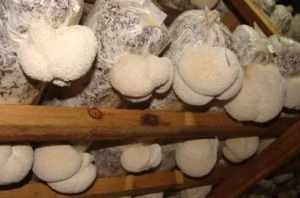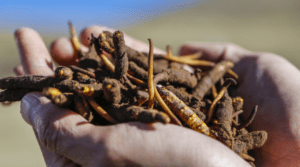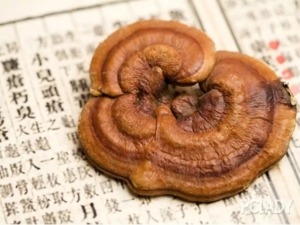-
Lion’s Mane
Lion’s mane (Hericium erinaceus), an edible and medicinal mushroom species, is widespread across East Asia. Its medicinal properties have been known for several ages, as evidenced by its use in traditional Asian folk medicine. The bioactive compounds identified in Lion’s mane include indole, fenol, steroid, and lactone compounds, terpenoids (erinacines, hericerins, and hericenones.), alkaloids (hericirine), polysaccharides, and glycoproteins. Both in vitro and in vivo studies have shown that these compounds act as antioxidants and immunomodulators and may also display antitumor, antidiabetic, and neuroprotective effects. Recent studies have proven further biological effects of Lion’s mane, which include defense against mitochondrial dysfunction, as well as against high levels of stress hormones; potential positive impact on gut microbiota in rodents and humans; and elevation of connectivity in the developing rodent brain. Thus, this species seems to modulate six out of nine mechanisms that could mediate the impact of diet on the major depressive disorder (MDD).
To date, three preclinical and three clinical studies have investigated the potential influence of Lion’s mane on affective functions. In a 2010 study on a small sample of 12 women undergoing menopause, 4-week supplementation with 2 g/day of powdered fruiting bodies of Lion’s mane caused a significant reduction in self-reported depression symptoms and indefinite complaints to levels that were—however—indistinguishable from the placebo group (n = 14), in which the reduction was also present, but statistically nonsignificant. This effect could not be driven by erinacines, the only compounds proven to date with the ability to cross the blood-brain barrier, as they are found only in the mycelium and not in the fruiting bodies of Lion’s mane. Interestingly, higher norepinephrine turnover (measured by free 3-Methoxy-4-hydroxyphenylglycol, i.e., MHPG levels in saliva), without any effect on self-reported somatic, anxiety, or depression symptoms in eight women (no placebo group was included in the study) after 4 weeks of supplementation with 585 mg/day of hericenone. Finally, in a subgroup of 15 obese individuals with high self-reported depression and anxiety symptoms, administration of 1.5 g/day of Lion’s mane (1.2 g mycelium, 0.3 fruiting body) for 8 weeks caused a reduction in both anxiety and depression symptoms.
A case study showed that an 86-year-old male MDD patient treated with fruiting bodies for 6 months was cured to remission. These results constitute a promising body of preliminary evidence for the potential use of Lion’s mane as a dietary supplement in patients with affective disorders. Currently, a low-sample (n = 40 participants per arm) phase II trial is being carried out to determine the efficacy of 6-month supplementation with Lion’s mane as an adjunct to pharmacotherapy with SSRIs or SNRIs. The symptoms will be measured eight times with the 17-item Hamilton Rating Scale for Depression.
The behavioral studies mainly used the Tail Suspension Test (TST) or Forced Swimming Test (FST) to measure the stress-coping strategy of rodents. In general, ADs change the behavior of animals from immobility (passive stress-coping) to swimming and climbing (active stress-coping). At the same time, factors that may be pathogenic in MDD (e.g., chronic stress, inflammation) have the opposite effect. Even a single p.o. administration of the same formulation in women caused a reversal of passive stress-coping induced by a pro-inflammatory agent (lipopolysaccharide, LPS). Of note, in the same experimental set-up (i.e., mice challenged with LPS and tested in TST and FST), The effects of ADs administered in at least ~10 higher doses than the daily human dose, which is common in pharmacological studies on mice. Many scientists observed behavioral results with chronic (4 weeks) supplementation with ethanolic extract of Lion’s mane at doses ranging from 60 mg/kg/day in healthy mice and from 200 to 400 mg/kg/day in animals subjected to restrain stress for 14 days. For reference, these doses were 2–10 times higher than those used in aforementioned human studies investigating the effects of Lion’s mane on depression symptoms.
In vivo studies in mice also confirmed two of the six mechanisms that could be associated with the effects of Lion’s mane on depression symptoms, which include the anti-inflammatory effect in the periphery as well as in the hippocampus and neurogenic and prosurvival effects on hippocampal neurons. In addition, mushroom supplementation (400 mg/kg/day) was found to restore monoamine (serotonin, dopamine, noradrenaline) neurotransmission in the hippocampus of stressed animals, which suggests that Lion’s mane may be a valuable adjunct to pharmacotherapy with SSRIs and SNRIs.
-
Cordyceps
Cordyceps (Cordyceps Sinensis( BerK.)Sacc) has been used in traditional Chinese medicine due to its immunostimulating effect, antifatigue properties, and beneficial effects against respiratory diseases.
The fruiting bodies and mycelium of Cordyceps Sinensis contain various bioactive compounds, including nucleosides (cordycepin), polysaccharides, amino acids (γ-aminobutyric acid, ergothioneine), and phenolic compounds (phenolic acids and flavonoids).
Several in vivo studies on rodents have investigated the effects of Cordyceps on physiological, neurobiological, and behavioral changes induced by stress. We observed changes in the weight of four glands (thymus, spleen, and adrenal and thyroid glands) in rats that were supplemented with a hot water fraction of Cordyceps Sinensis for 8 days. We reported that the supplement counteracted the effects of 2 days of stress in the tested animals. Of note, the authors found that C. Sinensis boosted swimming endurance in mice, which suggests that all behavioral studies that rely on the timing of a physical activity requiring exertion, such as FST and TST, should be interpreted with caution.
Scientists compared the effects of 5-day supplementation with hot water and superficial fluid extracts of C. Sinensis in TST. They concluded that even 10-fold higher doses of hot water extract did not influence the mobility of mice. However, the superficial fluid extract caused an increase in mobility when administered at 5 and 10 mL/kg, without any effect on spontaneous locomotor activity in the open field test, which suggests that the TST results should be interpreted in terms of a switch from passive to active stress-coping. Moreover, the authors explored the involvement of three monoaminergic neurotransmission systems (i.e., dopaminergic, noradrenergic, and serotonergic) in the observed effects. They found that α1-adrenergic and D2-dopaminergic receptor antagonists (prazosin and sulpiride, respectively) attenuated the effect of 10 mL/kg superficial fluid extract in the TST—a result that was not observed after the inhibition of serotonin synthesis by p-CPA. The conclusion drawn based on TST that C. Sinensis did not act via serotonergic neurotransmission was strengthened by the lack of effects of the extract on 5-HTP-induced head twitch response.
Since mushrooms can absorb and accumulate trace metals, We examined the effect of 4-week administration of vanadium-enriched C. Sinensis on stress-coping in diabetic rats. A study showed that treatment with C. Sinensis reversed the effect of streptozotocin-induced diabetes and returned passive coping (immobility) to healthy control levels through climbing behavior, which is mediated by noradrenergic neurotransmission. However, rats treated with C. Sinensis also spent twice as much time as healthy controls in active stress-coping via swimming, which is mediated by serotonergic neurotransmission. Moreover, the observed effects could not be attributed to vanadium, as the metal itself had no effect in modified FST.
Unfortunately, scientists did not control for the possible effects of C. Sinensis on spontaneous locomotor activity, which—if elevated—would point to the stimulating effect of the mushroom extract or perhaps restoration of normal metabolism in diabetic animals rather than an influence on stress-coping. Such an interpretation would explain the contradictory results regarding the involvement of the serotonergic system in the effects of C. Sinensis. Indeed, evidence from several rodents and human studies indicates the ability of Cordyceps to counteract the physiological effects of exertion/effort. The only other study investigating the effect of Cordyceps mushrooms on streptozotocin-induced diabetes in stress coping was performed with Ophiocordyceps formosana. The study showed no effect on locomotor activity in diabetic mice but restoration of active stress-coping, accompanied by increased dopamine and serotonin levels in the hippocampus and frontal cortex. Since both C. Sinensis and O. formosana have common bioactive compounds, it can be assumed that the doubling of swimming time in the modified FST was indeed mediated by serotonergic neurotransmission.
This hypothesis is supported by research on the isolated effects of one of the bioactive compounds of Cordyceps—cordycepin. We compared the effects of 21-day p.o. administration of 20 and 40 mg/kg cordycepin with 15 mg/kg fluoxetine in mice with chronic unpredictable mild stress. Like fluoxetine, at both doses, cordycepin reversed the behavioral effects of stress in the sucrose preference test (measuring consummatory anhedonia), open field test (measuring anxiety-like behaviors), TST, and FST. In addition, the treatment induced an anti-inflammatory response, rescued the levels of BDNF, and, most importantly, upregulated 5-HT2A (serotonergic receptor) protein levels and serotonin (and dopamine) neurotransmitters’ levels in the hippocampi of stressed mice. Interestingly, similar behavioral and biochemical results for dopaminergic and serotonergic neurotransmission in the hypothalamus and frontal cortex were observed in rats subjected to chronic unpredictable mild stress and subsequently treated with a parasitic fungus commonly found on C. Sinensis.
We investigated the effect of cordycepin on active stress-coping and observed that subchronic (3 days) i.p. injections of 5–12.5 mg/kg did not influence the locomotor activity of mice, while inducing active stress-coping after both acute and subchronic (5 days) treatment in TST and FST. The scientists also noted that acute cordycepin increased the levels of AMPA-glutamatergic receptors in the prefrontal cortex by inducing phosphorylation at the S845 site of the GluR1 subunit of the receptor. This effect was also observed in the hippocampus after subchronic treatment. Cordyceps supplementation impacted an intracellular signaling pathway (ROCK2/PTEN/Akt) in the rodent prefrontal cortex, which is known to converge on targets leading to phosphorylation at the S845 site of the GluR1 subunit.
In summary, preclinical in vivo studies on Cordyceps mushrooms and their bioactive compounds have proven that they affect at least four out of nine mechanisms (i.e., inflammation, oxidative stress, HPA function, and neurogenesis) that could be associated with the effects of diet on depression. More clinical studies are, however, needed to verify the antidepressive potential of Cordyceps mushrooms. Currently, a triple-blind randomized controlled trial is ongoing in Taiwan to evaluate the impact of Cordyceps supplementation on self-reported mood and blood cortisol levels in adults with lowered mood.
-
Ganoderma lucidum
The major bioactive compounds in Ganoderma lucidum (Reishi, Lingzhi) are polysaccharides and triterpenes (ganoderic and lucidenic acids). Chemical analyses of this mushroom species also revealed the presence of alkaloids and phenol compounds. This species has been used in Asian folk medicine as an antidiabetic, antihypertensive, and antitumor agent. Triterpenes, responsible for these effects, account for 0.244–0.444% of dried fruiting bodies and 0.555% of dried mycelium. The concentration of triterpenes in the dried fruiting bodies of Ganoderma lucidum has been estimated at a range of 2.44–4.44 mg/g and in dried mycelium at around 5.55 mg/g, with the highest amounts of triterpenes found in the antlered form of the mushroom. The concentration of polysaccharides in in vitro-produced G. lucidum was estimated at around 1.5 mg/g DW, and the content of polysaccharides is successfully increased up to ~40% by genetically manipulating the metabolic pathways of the mushroom.
 Research on the mechanisms involved in the functioning of the nervous system has shown that triterpenes isolated from G. lucidum can selectively inhibit acetylcholinesterase with moderate affinity to the protein, as well as exhibit neuroprotective effects in vitro. However, no in vivo studies investigating stress reactivity have been performed on triterpenes isolated from G. lucidum. Since both water extracts of mycelium and alcohol extracts of the fruiting bodies of G. lucidum have been shown to reduce passive stress-coping of rodents in FST, it seems worthwhile to conduct further studies on these extracts.
Research on the mechanisms involved in the functioning of the nervous system has shown that triterpenes isolated from G. lucidum can selectively inhibit acetylcholinesterase with moderate affinity to the protein, as well as exhibit neuroprotective effects in vitro. However, no in vivo studies investigating stress reactivity have been performed on triterpenes isolated from G. lucidum. Since both water extracts of mycelium and alcohol extracts of the fruiting bodies of G. lucidum have been shown to reduce passive stress-coping of rodents in FST, it seems worthwhile to conduct further studies on these extracts.
On the other hand, studies on polysaccharides from G. lucidum conducted in chronically stressed mice have not only confirmed their abovementioned behavioral effects but also shown their ability to decrease serum corticosterone levels, modulate glutamatergic neurotransmission, BDNF levels, and immunoreactivity in the hippocampus, as well as modulate serotonergic and noradrenergic neurotransmission, BDNF levels, and synaptic plasticity in the prefrontal cortex.
Interestingly, the only clinical study performed on a modest sample size confirmed the positive effects of G. lucidum on the affective well-being of humans treated with a mushroom extract with a 25% standardized content of polysaccharides. In this randomized, double-blind, placebo-controlled study of 123 Chinese patients suffering from neurasthenia, 8-weeks dietary supplementation (5.4 g/day) caused a reduction in fatigue and an improvement in well-being in 51.6% of participants (n = 62), compared to 24.6% of patients (n = 61) in the placebo group. Although similar results were observed in a pilot clinical trial investigating the effect of 4-week treatment with Ganoderma lucidum(reishi) spore powder (3 g/day) on depression and anxiety scores of 22 breast cancer survivors, a longitudinal study in the same population showed no effect of G. lucidum on the psychological well-being of 2440 former cancer patients after 6 months and 1501 survivors after 36 months. Additionally, breast cancer survivors who included G. lucidum fruiting bodies in their diet reported worsening their physical well-being and improving their social well-being. Still, since this was not an experimental study, causal conclusions could not be drawn. Lastly, in a randomized, double-blind, placebo-controlled pilot study of 26 women who have fibromyalgia, 6-week administration of G. lucidum (6 g/day) was not found to be more effective than placebo (n = 24) in improving life-satisfaction scores.
In summary, preclinical in vivo studies carried out to date have shown that G. lucidum-derived polysaccharides modulate at least three out of nine mechanisms (i.e., inflammation, HPA function, and neurogenesis) associated with the effects of diet on depression.

Leave A Comment